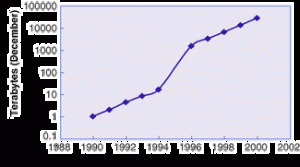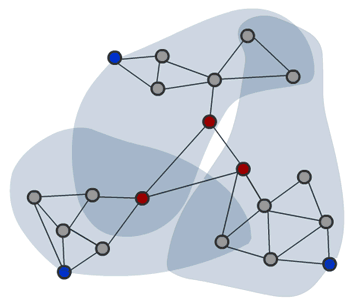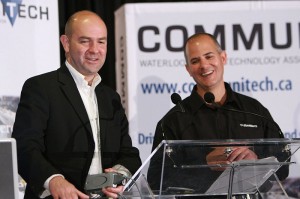 In today’s knowledge-based economy, much discussion centres around the importance of clustering. For example, in financial services, cities like New York, London and Toronto have all benefited at the expense of smaller rivals (eg. Philadelphia, Paris and Montreal or Vancouver). Likewise, as entrepreneurial technology startups have spread around the world, the Silicon Valley remains a magnet and model for that magic blend of people, ideas and capital aspiring to create the next Microsoft or Google. Furthermore, in spite of the world-flattening ascendency of information technology over the last decade, in some ways, the forces of such clustering seems to have increased.
In today’s knowledge-based economy, much discussion centres around the importance of clustering. For example, in financial services, cities like New York, London and Toronto have all benefited at the expense of smaller rivals (eg. Philadelphia, Paris and Montreal or Vancouver). Likewise, as entrepreneurial technology startups have spread around the world, the Silicon Valley remains a magnet and model for that magic blend of people, ideas and capital aspiring to create the next Microsoft or Google. Furthermore, in spite of the world-flattening ascendency of information technology over the last decade, in some ways, the forces of such clustering seems to have increased.
Being domiciled in Canada, and having built transatlantic technology companies over the years, led me to ponder Chris Anderson‘s recent endorsement of distributed workface in which he “builds companies that are distributed because that’s where the best people are.”
So, what’s the stronger force: clustering or distributed teams? First, let’s dig a bit into history so we can follow this trend.
The 1980’s: Selling Software in a Pre-web World
In the late 1980’s, an otherwise bright, young MBA student advised MKS to conquer local markets (ie. Waterloo Region) before going national and only then to export markets. While this may have made sense in traditional industries, we had the good sense to ignore this faulty gem of wisdom. Instead, reckoning that a dollar spent marketing in the US would reach about 10 times the audience as one dollar spent in Canada, we rejected this advice and focused from day one on selling our first product (MKS Toolkit) into the US market. To provide some context to modern readers, in these pre-web times software companies put ads in the back of magazines with dealers with geeky names like Programmer’s Shop and Programmer’s Paradise, with a several month cycle from ad spend to results. It’s easy to forget that, in those days, software companies had a “manufacturing” group which duplicated diskettes and shrink-wrapped them in boxes with physical manuals. Our main tactic to overcome geography was to use a North America-wide toll free 800 number to mask our country of origin, at least for first customer contact.
In my case, it helped that I had my first software startup experience in the US while building Coherent. This gave me direct operating experience in the Silicon Valley from the beginning. While importing that model of company development back to Waterloo probably wasn’t a 100% fit, it did serve to shape our biases in company structure to a very large degree.
The 1990’s: The Israeli Model
As the 1990’s unfolded, better IT systems, lower cost telephony and the emergence of the internet, web (and its precursors such as AOL), created an environment that was ideal for what I call the “Israeli Model” of technology company formation. In this model, R&D and “back office” functions resided in Israel, while much of the sales, marketing and business development (ie. the storefront of the company) was in the US – typically in the Silicon Valley. Companies like Aladdin, Checkpoint Software and Mercury Interactive all are good examples from the 1990’s.
Why did this model make sense? Israel is a small country with a tiny home market, having a population of just over 7 million. At the same time, it is a rich country (22nd in GDP per capita) with extremely high educational standards and a military establishment that was pushing the boundaries of research into many IT-related disciplines. Thus, Israel was an ideal cluster of brainpower and ideas to create new technology startups. However, the market was elsewhere. Between Tel Aviv and San Francisco there is an inconvenient, and inescapable, 10 hour timezone difference and up to 20 hours of flying time. To help overcome this a bi-modal company structure evolved, often with half of the staff (the back end) in Israel and the other half (the front end) in the USA. It’s a time tested model that has proven remarkably resilient.
As a result, despite its apparent disadvantageous geographic location, today Israel is second only to America in the number of NASDAQ-listed companies, and the Economist says that “the country attracts twice the number of venture-capital (VC) investments as the whole of Europe”.
It may seem odd, given how close Canada is to the US, to suggest that the same model made sense for Canadian companies as well. However, especially in the 1990’s, these key business drivers were essential to MKS or any other Canadian technology company with global aspirations:
- corporate image: many Americans like to buy local, so having a strong (front end) presence in the US will definitely improve both the sales, and even investment and valuation, prospects of the company.
- senior talent: sales and marketing executives with expertise in the software industry were effectively nonexistent in Canada. MKS source both its VP Sales and VP Marketing from the US. It was a great choice that allowed us to access top talent from major competitors. Furthermore, these executives provided mentorship, by acting as role models for the Canadian-based employees.
This was a virtuous circle, in which better US image helped to increase company value, attract ever better talent and ultimately should provide long term exit options.
Why not split the R&D organization as well? Notwithstanding our adoption of the Israeli Model, MKS resisted moving to multiple development locations until the very late 1990’s. Ironically, being a company that sells software to manage multi-site development, the state of the art in telecommunications and software adoption was still too primitive in those days and face to face communications continued to be critical. However, as the internet and bandwidth continued to develop and once MKS embarked on a series of acquisitions across the US, we did invest heavily in the new, IP-based room conferencing systems to knit geographically dispersed teams. It remains clear that until very recently, a single location for development has been preferable, particularly in the formative, early stages of product innovation.
Best Practices Today
Today, we live in a business world that routinely accepts offshoring, virtualized management, distributed teams, etc. Tools like Basecamp, Enterprise Wikis, iotum‘s rich conferencing, and even instant messaging for real time back channel, all make distributed innovation sessions (aka meetings) much more practical. What is most interesting is the fact that video plays only a very small part in all of this.
After years of evolving startup playbooks, we may be finding the right balance between the more traditional “Israeli Model” and the fully decentralized team as espoused by Chris Anderson. At Coreworx (Software Innovation), we moved the company to Waterloo largely to gain synergies, at a critical early stage, in what was then a 20 person team. So, there are clearly some benefits that remain from people interacting face to face and always will be. The most creative and innovative processes may well work best only when conducted in person. Further more, with the rise of mobile nomadism, less and less work seems to be conducted in the traditional office setting.
That being said, each year we seem to be able to achieve more by ignoring geography and building around the best talent. Conversely, I have a feeling that the convivial, chalkboard-centric environment at Waterloo’s Perimeter Institute may well be crucial to the breakthroughs in fundamental physics that institution will undoubtedly generate. What is your take on the necessity of clustering talent?


 No, not like this!
No, not like this!

 In a world full of change, do maturity and learned experience continue to have value? Absolutely. Serial entrepreneurs learn to “replay a tape” of past successes, and even more importantly, to avoid pitfalls that have bedevilled them in the past. However, replaying the tape is much more complicated as the pace of change accelerates. A good analogy is that you are replaying the tape as the format transitions through
In a world full of change, do maturity and learned experience continue to have value? Absolutely. Serial entrepreneurs learn to “replay a tape” of past successes, and even more importantly, to avoid pitfalls that have bedevilled them in the past. However, replaying the tape is much more complicated as the pace of change accelerates. A good analogy is that you are replaying the tape as the format transitions through 
 If you want to learn from first hand from Ariane de Bonvoisin on the subject of “Taking Charge of Change”, or even ask your own questions, sign up for her 21 August, 2008
If you want to learn from first hand from Ariane de Bonvoisin on the subject of “Taking Charge of Change”, or even ask your own questions, sign up for her 21 August, 2008 
 Ed Iacobucci, CEO Dayjet
Ed Iacobucci, CEO Dayjet For every Ed Iacobucci, there were many dot com era fibre and telecom firms that, despite all hard data to the contrary, ran their businesses into the ground on the false proposition that the
For every Ed Iacobucci, there were many dot com era fibre and telecom firms that, despite all hard data to the contrary, ran their businesses into the ground on the false proposition that the 


 First of all, Chris Anderson, editor of
First of all, Chris Anderson, editor of  Having already seen venture investor and advisor Chris Sacca doing a similar presentation at the
Having already seen venture investor and advisor Chris Sacca doing a similar presentation at the  The interplay of the two Chris’s (Anderson and Sacca) with later keynote Jeff Taylor (
The interplay of the two Chris’s (Anderson and Sacca) with later keynote Jeff Taylor ( Again, major kudos to Communitech for pulling this remarkable event together. It is a real step forward for the Waterloo startup scene. To illustrate, less than three years ago, at October 2005 Entrepreneur Week, when Tony Perkins (
Again, major kudos to Communitech for pulling this remarkable event together. It is a real step forward for the Waterloo startup scene. To illustrate, less than three years ago, at October 2005 Entrepreneur Week, when Tony Perkins (










 It seems that several people missed the “Comments” link where Grover posted his materials for the Venture 2.0 Playbook. Therefore, I’m reposting his comments with the link here below. Also, although we’ve had some great dialogue offline about this extremely important topic, I’d like to see some here.
It seems that several people missed the “Comments” link where Grover posted his materials for the Venture 2.0 Playbook. Therefore, I’m reposting his comments with the link here below. Also, although we’ve had some great dialogue offline about this extremely important topic, I’d like to see some here.
11 Aug 2008
0 CommentsEntrepreneurial Toolkit #5: The Power of Two (or Three)
As an investor, the most important lesson I’ve learned over the years is that great companies are built by great teams. Furthermore, great teams rarely are one superhuman “A” player surrounded by a supporting cast of “B” players. And unlike the Borg Collective which seeks to “… add your biological and technological distinctiveness to our own”, great management teams need to have a set of complementary, yet overlapping, skill sets.
Most of us know the example of how Steve Wozniak the brilliant hardware designer teamed up with the uber-persuasive Steve Jobs to create Apple, an iconic Silicon Valley startup success story. While that partnership didn’t last forever, it’s pretty clear that the fusing of the talents of these two brilliant individuals directly led to Apple’s early success. I encourage you to read more in a “must read” book I’ve recommended earlier, Founders at Work.
Here in Waterloo, Research in Motion (RIM) would not be today’s superstar company unless Jim Balsillie joined engineer, founder, Mike Lazaridis. Until Jim joined Mike in the early 1990’s, RIM had long remained a typical engineering oriented company doing about $500 000 annual revenues from 20-odd products. Although Jim could never have built the products, his introduction to the management brought the marketing and financial drive and focus that ultimately led to the Blackberry led success story we know today. Rather than the cult of the individual, once again it is the power of this amazing duo that built RIM.
What is unusual about this case is that both Mike and Jim share the title CEO, billing themselves as co-CEOs. Perhaps more companies should consider this approach?
Back in 1995, as MKS was starting to look to the capital markets, one of my personal inspirations, Reed Hastings CEO of Pure Software (and now Netflix), observed that “Pure Software has built a team where any of the senior management team could be CEO”. I certainly took that approach to heart when building MKS’s great team and it has been an important insight ever since.
For example, Chuck Bay, who was Pure’s CFO at the time has subsequently gone on to be CEO Broadbase Software (acquired by KANA) and President and CFO of Spatial Technology. Rob Dickerson, who was VP & GM of Developer Tools for Pure, a key operationally focused executive, subsequently became CEO of Faves and President, CEO of Pacific Edge Software (acuired by Serena Software) and EIR at Ignition Partners. These are just two data points illustrating the calibre of the team Reed built at Pure Software.
At MKS, we managed to build an amazing team, especially in the mid-late 1990’s with superstars like Ruth Songhurst, Eric Palmer, Tobi Moriarty, Michael Day, Frank Pfeiffer and Paul Laufert. It was a great mix, with stars from Canada, US and Germany. As well, almost uniquely, we had a balance of the genders. It is a big disappointment to me that I continue to see how rare that is.
To round out our discussions, anyone wanting a deeper grounding in this important topic should read the book Co-Leaders: The Power of Great Partnerships by David A. Heenan and Warren Bennis, John Wiley & Sons, 1999. With the thesis that great organizations need “more than a visionary CEO”, the bookoutlines the rare, but critical, role building a strong management team takes in building exceptional companies.
To summarize this book, in the authors’ words, “Co-leadership . . . is a tough-minded strategy that will unleash the hidden talent in any enterprise. Above all, co-leadership is inclusive, not exclusive. It celebrates those who do the real work, not just a few charismatic, often isolated, leaders who are regally compensated for articulating the oranizations’ vision”. Although, like many it has taken me years to learn this valuable lesson, I couldn’t say it better myself.
There are lots of detailed case studies, from companies in many industries, with a few key lessons for co-leaders, including:
To reiterate, great companies are almost always built by great teams. As organizations and markets get more complex, I believe co-leadership will become increasingly the norm. For smart and successful people to control their egos takes a lot of maturity. Furthermore, the ideal team depends, in large part, on the stage and growth of the company. As I’ve learned, great teams take a lot of work to build, but can also dissipate over time. Indeed, they are a rare and fragile flower, to be cultivated constantly.
Nonetheless, it is definitely worth any entrepreneur’s full time and attention to unleash the power of the team – whether a gestalt of two, three or even more remarkable individuals.